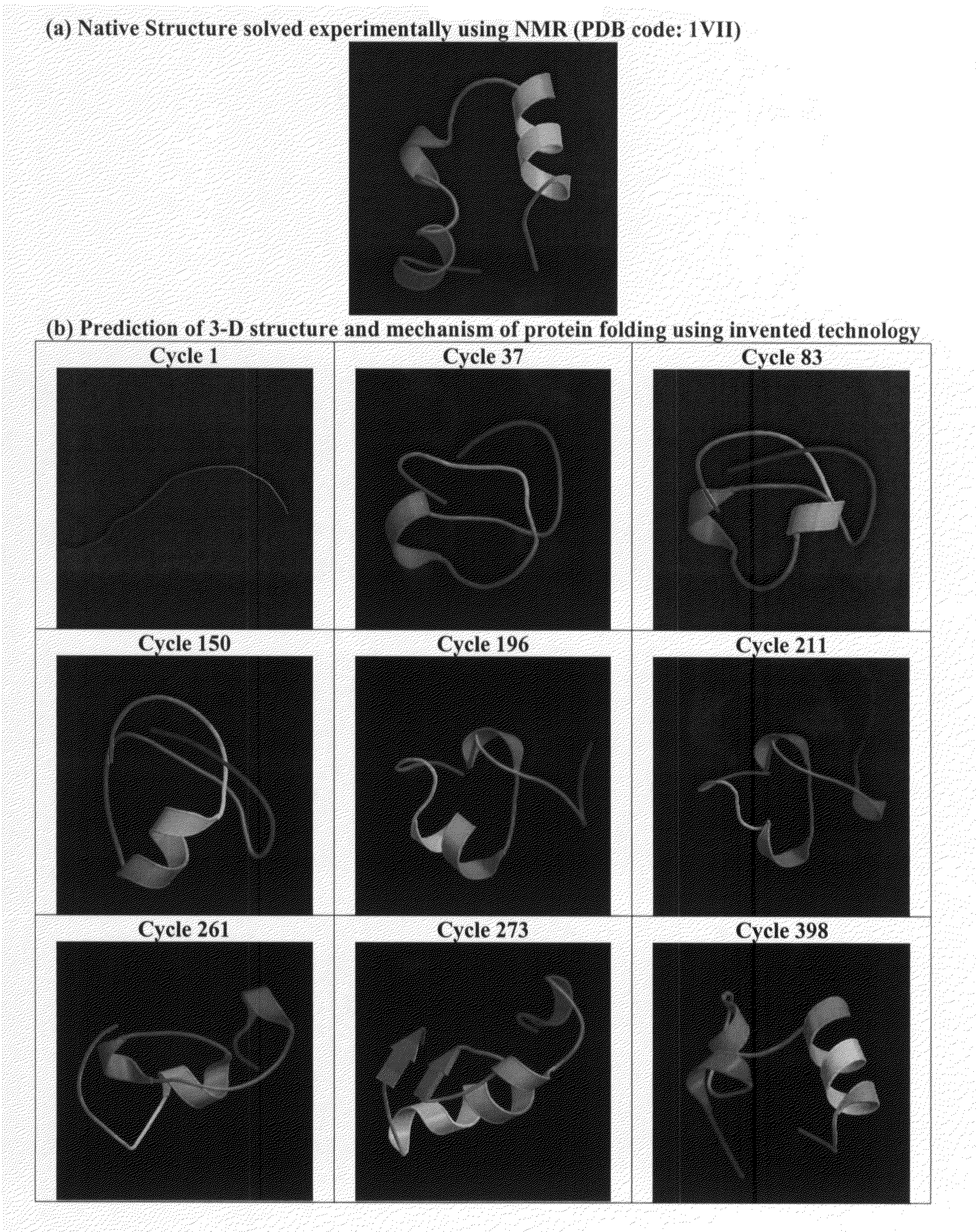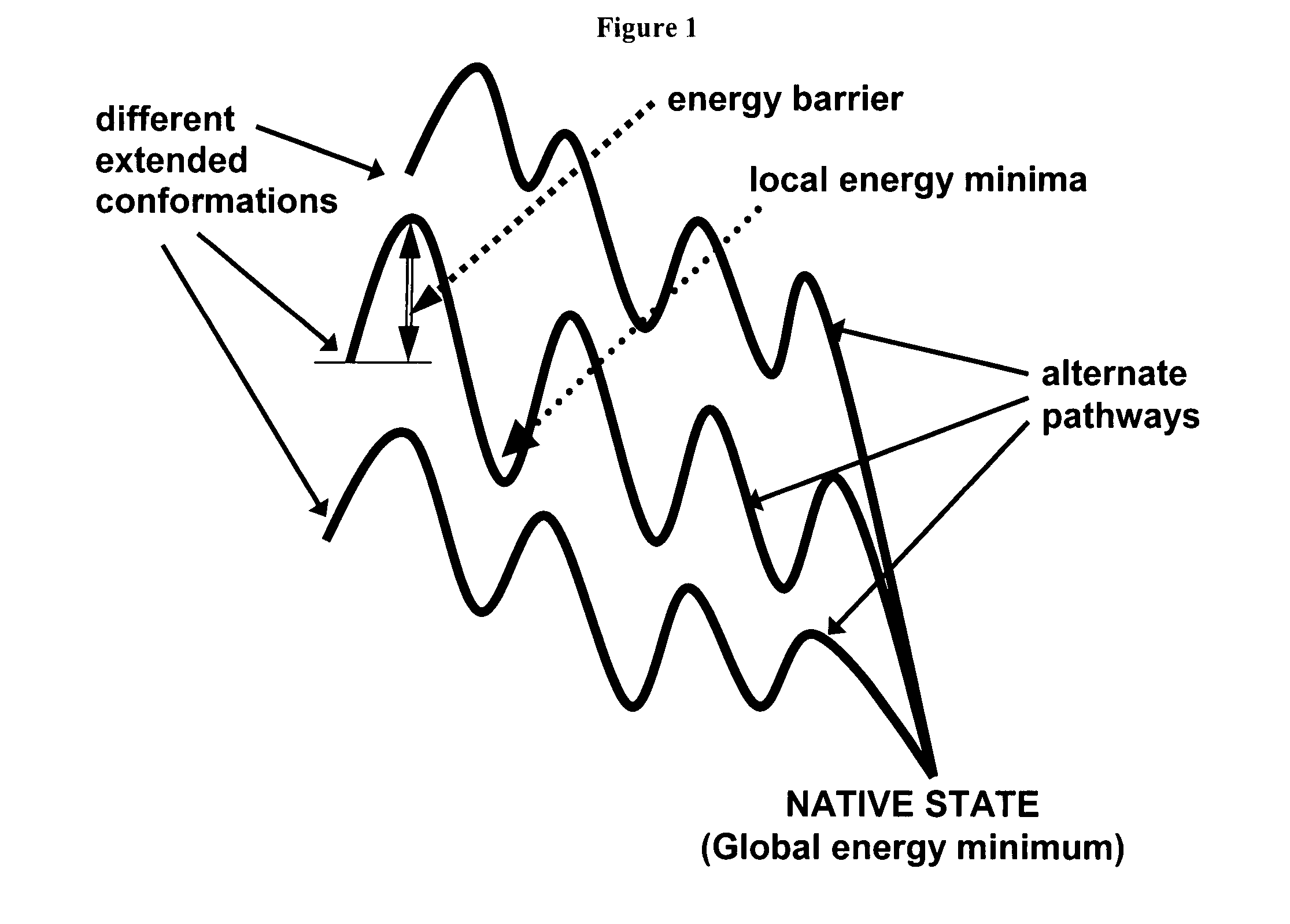Fast computational methods for predicting protein structure from primary amino acid sequence
a protein and sequence technology, applied in the field of prediction of the three-dimensional structure of a protein and can solve the problems of limited success, methods are not able to discern and the fundamental understanding of the mechanism of protein folding is very poorly understood, so as to improve the kinetics of protein folding, prevent misfolded or possibly disordered proteins, and stabilize proteins
- Summary
- Abstract
- Description
- Claims
- Application Information
AI Technical Summary
Benefits of technology
Problems solved by technology
Method used
Image
Examples
example 1
[0091]Thermostable Subdomain from Chicken Villin Headpiece
[0092]The present invention was used to determine the 3-dimensional structure as well as to investigate the mechanism of protein folding for the chicken villin headpiece protein. The chicken villin headpiece peptide is a 36-residue peptide, with known experimental structure solved using NMR (This structure is available from PDB code: 1 VII). This analysis was performed by addition of kinetic energy to protein vibrational modes to overcome the energy barriers during the mechanism of protein folding. This was investigated using addition of kinetic energy to overcome the energy barriers during the mechanism of protein folding. For this example we used the implicit model description of the solvent (to accelerate the calculation). The calculations were performed using AMBER (J. Computat. Chem. 26, 1668-1688, 2005) force field (parm03) and the EM / MD engine sander (which is available as a part of AMBER package). More details about t...
example 2
The Native State of Ubiquitin
[0094]In this example the mechanism of protein folding for the protein ubiquitin was investigated and important protein regions were identified for the process of protein folding. Ubiquitin is a single chain protein composed of 76 amino acids and is a fully functional and naturally occurring protein present in living cell. Starting with a fully extended conformation in explicit solvent the ubiquitin structure was subjected to over 100 iterative cycles of the algorithm. As described in Example 1 above, AMBER package and force-field (parm 98) were used for setup, energy minimization and molecular dynamics runs. Note, this example used “displacement of protein structures along the vibrational mode” during stage 3. FIG. 8 depicts the variation of system energy and surface area as a function of the cycles and FIG. 9(b) depicts ubiquitin secondary structure at the end of selected cycles. A value of η=20 was used during the first 14 cycles, where a steady decre...
example 3
[0096]Dihydrofolate reductase is a fully functional protein which functions as an enzyme. This protein is the target of anti-malarial and anti-cancer drugs. The power of the present invention is fully demonstrable in this example. This protein has more than 100 amino acid residues The sequence of dihydrofolate reductase from the bacterium Escherichia coli has 159 residues. The present technology was used to start from an extended conformation, in combination with implicit solvent model for water (generalized Born method). The preparation was similar to Example 1, where AMBER force-field (parm03) and package was used to prepare an extended conformation. The protein structure was subjected to 92 cycles of the present technology. Each cycle consisted of 10 picoseconds MD at stage 1; 5 picoseconds MD at stage 2; and 20 simultaneous searches using 10 vibrational modes (in positive / negative directions) with 10 picoseconds MD at stage 5.
[0097]As indicated in FIGS. 10...
PUM
 Login to View More
Login to View More Abstract
Description
Claims
Application Information
 Login to View More
Login to View More - R&D
- Intellectual Property
- Life Sciences
- Materials
- Tech Scout
- Unparalleled Data Quality
- Higher Quality Content
- 60% Fewer Hallucinations
Browse by: Latest US Patents, China's latest patents, Technical Efficacy Thesaurus, Application Domain, Technology Topic, Popular Technical Reports.
© 2025 PatSnap. All rights reserved.Legal|Privacy policy|Modern Slavery Act Transparency Statement|Sitemap|About US| Contact US: help@patsnap.com



